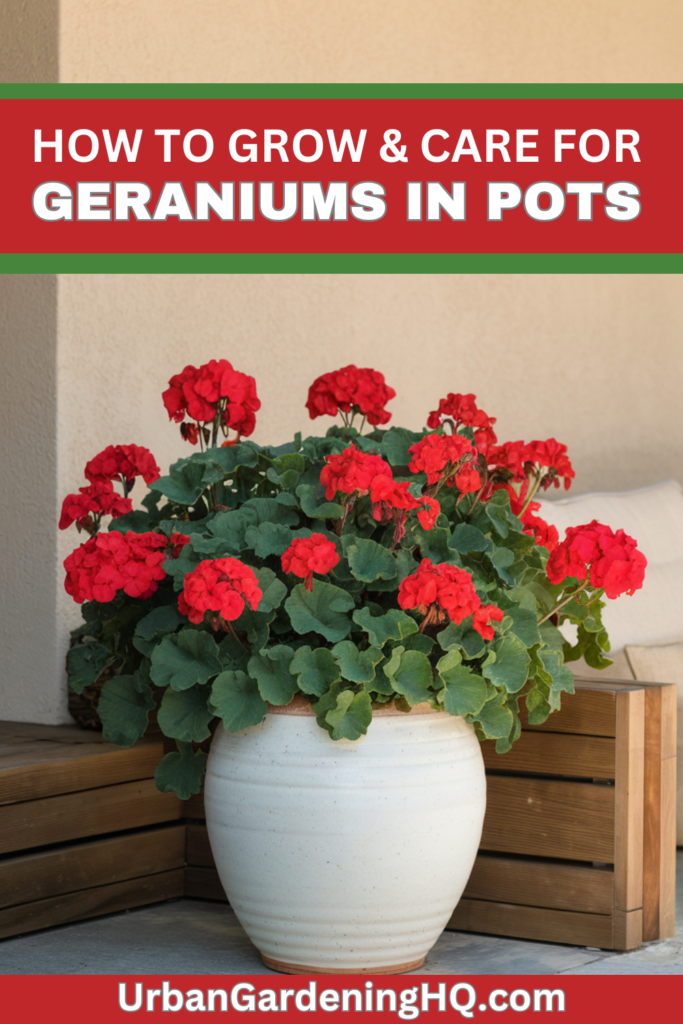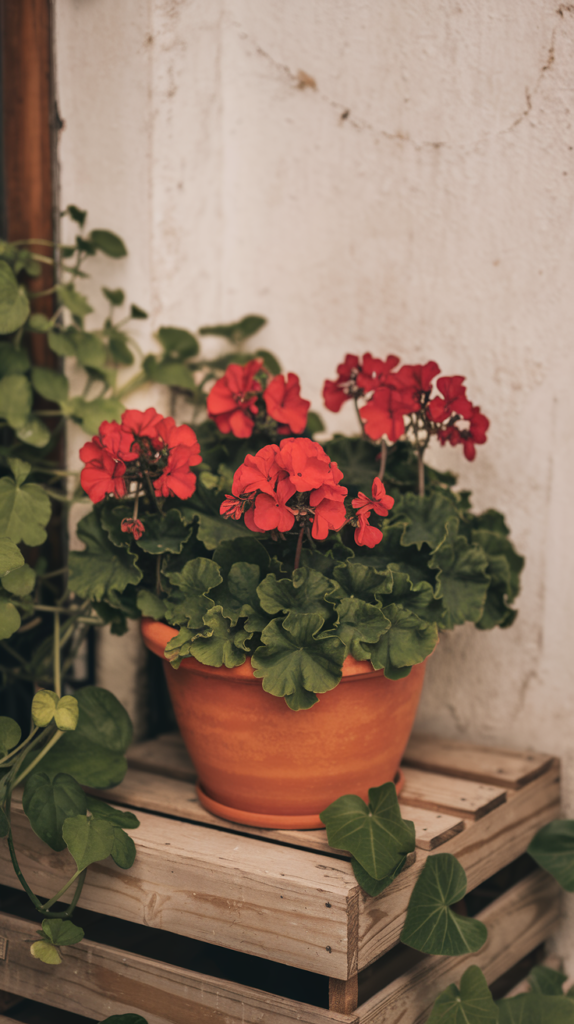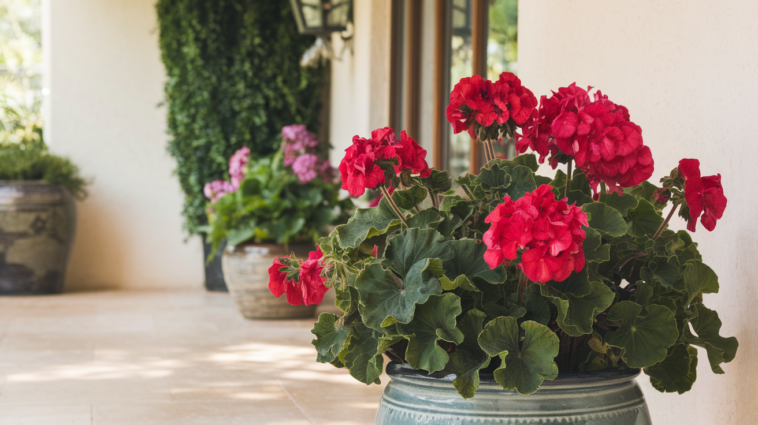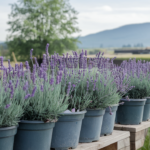Geraniums are a favorite among gardeners for their vibrant blooms, delightful fragrance, and ability to thrive in containers. Whether placed on a sunny balcony, patio, or windowsill, potted geraniums bring a burst of color and charm to any space.
With the right care, they will bloom profusely from spring through fall, rewarding you with lush flowers and lush green foliage. Growing geraniums in pots is a fantastic way to enjoy their beauty while maintaining control over soil quality, drainage, and placement.
Choosing the Right Geranium Variety for Pots

Not all geraniums grow the same way, so selecting the right variety for container gardening is essential. Zonal geraniums (Pelargonium hortorum) are a popular choice due to their upright growth, striking foliage, and large, eye-catching blooms. Their sturdy stems and compact habit make them perfect for pots.
Ivy geraniums (Pelargonium peltatum) are another excellent option, especially for hanging baskets or raised planters. Their trailing vines spill gracefully over the edges of containers, creating a cascading effect adorned with delicate flowers.
For gardeners who love fragrant plants, scented-leaf geraniums (Pelargonium spp.) provide aromatic foliage with scents like rose, lemon, mint, or even chocolate. While their blooms are smaller, their unique scents make them a delightful addition to patios and balconies.
Regal geraniums (Pelargonium domesticum), often called Martha Washington geraniums, produce elegant, ruffled flowers in striking color combinations. These thrive in cooler temperatures, making them a fantastic choice for early spring and fall container displays.
Selecting the Right Pot and Soil
Geraniums need well-draining soil to prevent root rot, so choosing the right pot is just as important as selecting the right variety. A container with drainage holes is a must, as standing water can quickly lead to fungal diseases. Clay or terracotta pots are excellent choices because they allow excess moisture to evaporate, keeping the roots healthy.
For soil, a high-quality potting mix enriched with perlite or sand ensures proper drainage and aeration. Avoid using heavy garden soil, as it tends to retain too much moisture. Adding compost or organic matter to the mix helps provide essential nutrients and encourages robust growth.
Sunlight Requirements for Thriving Geraniums
Geraniums flourish in bright, direct sunlight and require at least six to eight hours of full sun per day. The more sun they receive, the better they bloom. If growing indoors, placing the pots near a sunny south- or west-facing window is ideal.
In extremely hot climates, geraniums appreciate some afternoon shade to prevent the leaves from scorching. Moving the pots to a slightly shaded area during peak summer temperatures can help them remain healthy and vibrant.
Proper Watering Techniques for Potted Geraniums
Watering potted geraniums correctly is crucial for their success. While they are relatively drought-tolerant, they prefer deep but infrequent watering. Allow the top inch of soil to dry out between waterings to prevent overwatering, which can cause root rot.
Watering in the morning is best, as it allows any excess moisture on the leaves to evaporate throughout the day, reducing the risk of fungal diseases. Always water at the base of the plant rather than overhead to keep the foliage dry and healthy.
During the hottest months, check the soil more frequently, as potted plants dry out faster than those in the ground. However, avoid letting the soil become bone-dry for extended periods, as this can stress the plant and affect blooming.
Fertilizing Geraniums for Continuous Blooms
Regular feeding encourages lush foliage and abundant flowers. Using a balanced liquid fertilizer every two to four weeks during the growing season helps maintain steady growth. A formula with a higher phosphorus content (the middle number on a fertilizer label) promotes more blooms.
Slow-release fertilizers are also a great option for those who prefer a low-maintenance approach. Simply mix the granules into the soil at the beginning of the growing season to provide a steady supply of nutrients. Organic alternatives, such as compost tea or fish emulsion, can also be used to feed geraniums naturally.
Pruning and Deadheading for Healthy Growth

To keep potted geraniums looking their best, regular pruning and deadheading are essential. Removing spent blooms encourages the plant to produce new flowers instead of directing energy toward seed production. To deadhead, simply pinch or snip off faded flower stalks just above a set of healthy leaves.
If the plant becomes leggy or overgrown, trimming back the stems by one-third helps maintain a bushy, compact shape. Pruning also improves air circulation, reducing the likelihood of pests and diseases. During late summer, a more significant cutback can rejuvenate tired-looking plants, encouraging fresh growth before the cooler months.
Overwintering Potted Geraniums Indoors
Since geraniums are tender perennials, they don’t survive freezing temperatures. However, they can be overwintered indoors to bloom again next season. Before the first frost, bring potted geraniums inside and place them in a bright location, such as a sunny windowsill or under grow lights.
Watering should be reduced during winter, as the plant enters a semi-dormant state. Allow the soil to dry out more between waterings, and avoid fertilizing until spring. As daylight hours increase, new growth will emerge, signaling that it’s time to resume regular feeding and watering.
Another method for overwintering is to take cuttings from healthy stems and root them in small pots indoors. This way, fresh plants can be started in the spring, ready for outdoor planting.
Common Problems and How to Prevent Them
Geraniums are generally low-maintenance, but they can sometimes face pests and diseases. Aphids, spider mites, and whiteflies are the most common pests, and they can be controlled by spraying plants with a mixture of water and mild dish soap or using neem oil.
Fungal diseases, such as powdery mildew and botrytis blight, occur in overly humid conditions. Ensuring good air circulation, avoiding overhead watering, and keeping plants properly spaced can help prevent these issues. If disease appears, removing affected leaves and applying an organic fungicide can help control the problem.
Yellowing leaves often indicate overwatering or poor drainage. Checking the soil moisture before watering and using a well-draining potting mix can prevent this issue.
Enjoying Beautiful Geraniums in Pots All Season Long
Growing geraniums in pots is a fantastic way to brighten up any outdoor or indoor space. Their vibrant flowers, easy-care nature, and long blooming period make them one of the best choices for container gardening. With the right soil, proper watering, and regular pruning, your potted geraniums will thrive, rewarding you with an abundance of colorful blooms throughout the growing season.
Whether placed on a balcony, patio, or sunny windowsill, these cheerful flowers bring a sense of joy and beauty to any setting. By following these simple care tips, you can enjoy lush, thriving geraniums in pots year after year.


